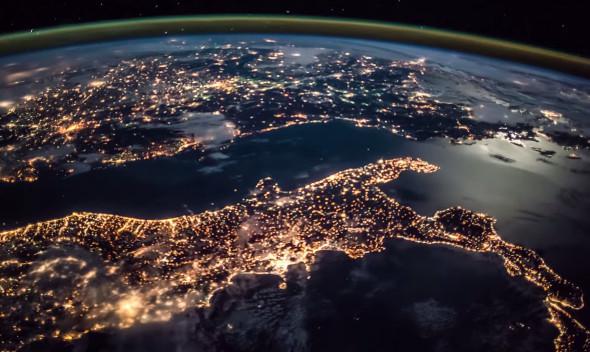I do love time-lapse animations of the Earth seen from the International Space Station, and if you do too, this is your lucky week: No fewer than three astonishing videos have been released in the past few days, and all three are absolutely worth your time to watch.
Make sure to set them to hi-def first! You don’t want to miss the details …
The first is short, and shows the view from the ISS looking down on Europe and Africa as it passes southeast down the Italy coast, across the Mediterranean, then across Egypt. I think you’ll find Italy and the Nile fairly obvious!
I like how you can see storms peppering the Egyptian and Israeli landscape. Bonus: The scene is lit by moonlight! You can even see the Moon reflected in the sea in the early seconds of the video. Incidentally, the green arc over the edge of the Earth is called airglow—at night, molecules in the Earth’s upper atmosphere slowly release the energy they gained from the Sun during the day.
Next is a much longer but even more wonderful video, featuring photographs of Earth taken by astronaut Alexander Gerst.
I love the sequence of the Dragon capsule being manipulated by the CANADARM 2 at 1:30. At 3:00 city lights like stars in space stream below, and then it cuts to the Milky Way above, like a poetic mirror of the cities. You can see parts of the space station lit, but again it’s the Moon not the Sun doing the illuminating.
At 3:36 a the solar panels turn to catch the Sun, watch the sky carefully: A distant satellite can be seen flying across the sky from the lower right to upper left.
One more thing to note: At 4:50 there’s a sequence showing the robotic arm moving the Cygnus resupply ship, Janice Voss, into position, which then flies away, destined to burn up in Earth’s atmosphere. It appears to move up, away from the Earth, which may strike you as odd since it’s supposed to head down! That’s a consequence of how orbital mechanics work; the ship had to boost to a higher orbit for safety, then do another rocket burn to dip the lower part of its orbit into the Earth’s atmosphere. I was so fascinated by this when that sequence was first released that I wrote an entire post explaining it. Rocket science is cool!
The final video is about astronaut Don Pettit, who was one of the first to start taking dedicated high-resolution photographs from the Space Shuttle and ISS missions. He worked very hard to figure out how best to take these photos, and in this video he talks about his work.
You can see more of his images turned into an animation created by Christoph Malin.
At first you might think these animations are just eye candy, but I think they’re much more than that. They show our planet from a perspective the vast majority of us will never see for ourselves. Simply seeing it from above shifts our preconceived notions of it, erases national borders, and shows global phenomena that tie our ideas of a divided Earth together.
There is science to be learned from all this, certainly, and it’s an honor to have the chance to point it out. But I strongly feel that the long-term effects of images and videos like this on our philosophy, our outlook, will have a more profound impact.
